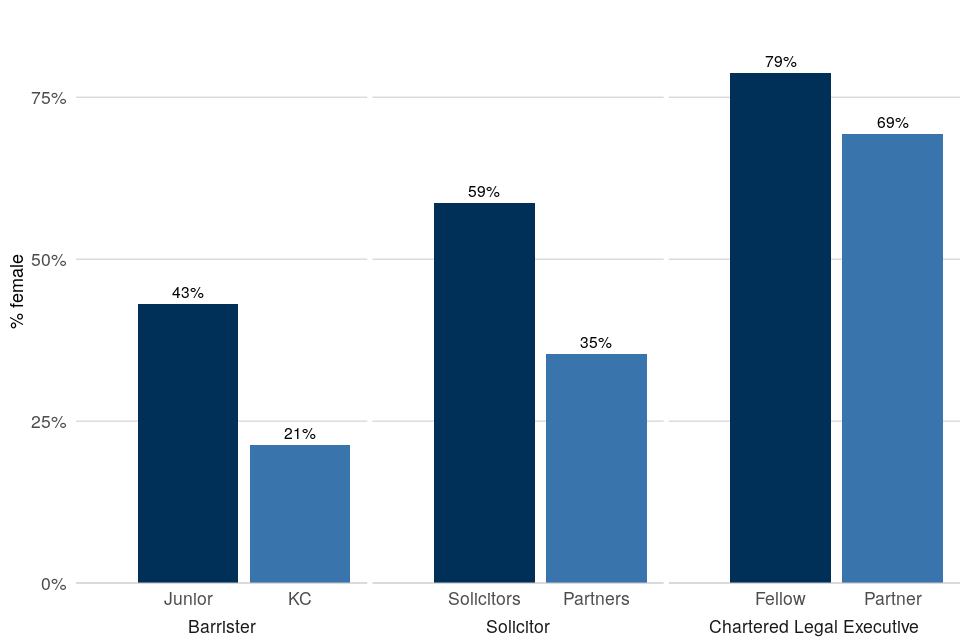Diversity of the Judiciary

By Law News
2024 Ministry of Justice Statistics indicate good progress being made to "level up" the Judiciary
The latest Ministry of Justice statistics for 2024 provide a comprehensive overview of judicial diversity in England and Wales, highlighting both significant strides forward and enduring challenges in achieving equitable representation across gender, ethnicity, and professional backgrounds.
Trends in Gender Representation
Gender diversity within the legal professions has shown notable improvement over recent years. Women now constitute substantial percentages of barristers (40%), solicitors (53%), and Chartered Legal Executives (77%). However, their representation on the judiciary remains lower at 43%, with significant disparities observed in senior judicial roles. Despite these challenges, there has been progress, especially in judicial applications and recommendations where women accounted for 52% and 53%, respectively, in 2023-24.
Proportion of female legal professionals by seniority, April 2024
For all three professions, the female proportion is lower at more senior compared to less senior levels.

Ethnic Diversity Progress
The journey towards ethnic diversity in the judiciary has been more gradual but steadily improving. From 2014 to 2024, ethnic minority representation increased among barristers (17%), solicitors (19%), and Chartered Legal Executives (11%). Despite these gains, ethnic minorities constitute only 11% of the judiciary, underscoring disparities compared to the broader working-age population demographics. Challenges persist, particularly in senior appointments where ethnic minorities are significantly underrepresented.
Proportion of senior and junior levels by ethnic minority group and legal profession, April 2024

Challenges in the Selection Process
The path from legal professional to judge involves rigorous selection processes where disparities persist despite equal qualifications among candidates. For instance, while solicitors make up a majority in applications (52%), they are less represented in recommendations (32%) compared to barristers, highlighting structural biases. Ethnic minority groups, particularly black candidates, face significant barriers in judicial appointments, with only 2% representation in recent statistics.
Progressive Initiatives
Efforts to enhance diversity include initiatives like the Equal Merit Provision, allowing the Judicial Appointments Commission to prioritise diverse candidates when qualifications are equal. This provision has facilitated advancements for candidates from mixed ethnic backgrounds compared to their white counterparts. Additionally, roles outside traditional legal pathways, such as magistrates and non-legal tribunal members, exhibit higher representation of women (57%) and ethnic minorities (13% to 18%), offering potential avenues for broader inclusivity within the legal system.
Representation in Legal Professions
Across legal professions, gender representation varies significantly with seniority. While women comprise 59% of solicitors, this drops to 35% among partners, indicating a significant disparity at higher levels. Similar trends are observed among barristers and Chartered Legal Executives, reflecting challenges in career progression and representation at senior leadership levels.
Ethnic Diversity in Legal Professions
The upward trajectory of ethnic minority representation in legal professions over the past decade—from 14% to 17% among barristers, 15% to 19% among solicitors, and 5% to 11% among Chartered Legal Executives—illustrates progress. However, disparities persist at senior levels, with lower percentages of ethnic minority professionals achieving higher seniority ranks compared to their white counterparts, despite gaining substantial post-qualification experience.
Judicial Appointments and Challenges
In the realm of judicial appointments, ethnic minority candidates constitute 15% of the eligible pool, reflecting interest and readiness to serve. However, recommendation rates for ethnic minorities (16%) lag significantly behind application rates (31%), indicating barriers in progression through selection stages. Specific exercises over the past three years have shown improvements for ethnic minority candidates in certain roles like Recorder and Deputy District Judge, yet achieving parity with white candidates remains a challenge across all exercises.
Representation of ethnic minority individuals among court and tribunal judges, 2014 to 2024

Moving Forward
While commendable progress has been made in enhancing diversity within the legal professions, persistent challenges remain, particularly at senior levels and in judicial appointments. Addressing these disparities requires concerted efforts from legal institutions, professional bodies, and policymakers. Strategies such as targeted support through mentorship programs, transparent recruitment practices, and fostering inclusive cultures within legal workplaces are essential for advancing diversity and ensuring equal opportunities for all professionals.
In conclusion, while the journey towards equitable representation in the judiciary continues, the legal professions are positioned to lead by example in embracing diversity and upholding fairness and justice in society. By leveraging data-driven insights and proactive measures, stakeholders can build a judiciary that reflects the rich diversity of the communities it serves, thereby enhancing public trust and reinforcing the rule of law in England and Wales.
